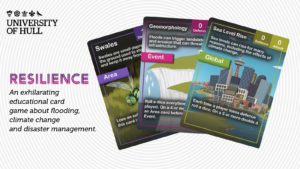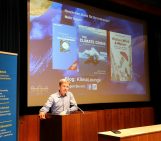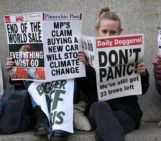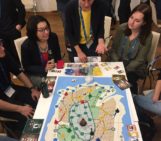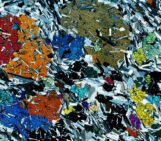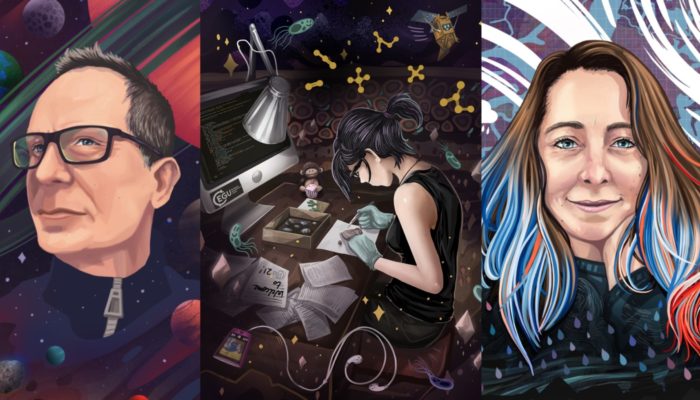
Scientific artist Kelly Stanford has sure come a long way since we last spoke to her in 2019. The Manchester, UK-based science communicator is a Physical Geography PhD candidate from the University of Hull’s Energy and Environment Institute and winner of EGU’s Artist (not) in Residence in 2021. This year, at the Union’s General Assembly EGU22, Kelly continued her series of “Sci-portraits” (portraits that fuse scientists with their research) of geoscientists participating in the meeting. She tells us about her passion for showing the more human side to research and hopes that her work will continue to help scientists incorporate interdisciplinarity into their research.
Excerpts from the interview:
Hi Kelly, congratulations again on your successful stint as EGU’s Artist (not) in Residence. Could you tell us about your journey creating sci-portraits, where you fuse scientists with their research? How did you find inspiration for this unique idea? 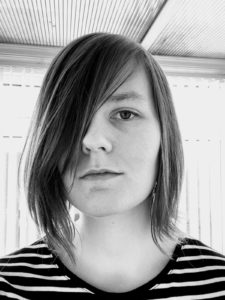
Sure. I had been experimenting with the idea of trying to represent the scientist and their work in the one art piece since 2018. At first, I focused on hands of the scientists holding or interacting with objects related to their work/research. I chose hands as they are quite striking and sometimes uniquely shaped. Some show signs of wear from working out in the field, others have tattoos that have intimate meaning to the person. I also like the connection between our hands, which are a biologic tool of ours, and the specialised tools we use during our research.
After a month or so making these hand illustrations I didn’t feel satisfied with the output. I liked the idea, but felt they weren’t striking enough. This was before I fully embraced digital art so maybe it would be different today? I should revisit the concept when I get time…
I think it was mid 2020 I was toying with the idea of taking what I’d started with the hands but scaling it up to combine the scientists portrait with their work. Portraits were something I hadn’t entertained much prior, minus the odd self-portrait here and there. So this project gave me the excuse to practice and get better. The first three were made for the BGS medallists that year – I posted them to Twitter and then everything kind of spiralled onwards from there. People found their concept very compelling, and many wanted their own, so I opened commissions. I also submitted for the 2021 EGU Artist in Residence role – which I was picked for, and then picked again for this year too! I’m coming up to my 100th portrait, which I plan to do of myself seeing as I somehow forgot to make myself one this entire time.
What was your experience working on geoscientist portraits during this year’s General Assembly?
Easier. I had the benefit of having enough practice done during last year’s General Assembly, so I knew what to expect and that allowed me to more effectively plan everything out. I was originally going to travel to Vienna, but there’s been a lot of turmoil at the local airport recently, so I chose to participate remotely again. I’m hoping to join in-person next year though!
Your work clearly spans several different genres and aspects of science communication, do you find differences in communicating within the various scientific disciplines?
I don’t believe in sticking to one discipline, topic or medium. I find it more effective if you best match the topic with the medium for a particular project. I think it’s crucial to experiment though, just to see what works and what doesn’t. Aiming to do something that’s never been done before or barely explored is also a healthy objective to strive for.
I find all mediums can be applied to all scientific disciplines, so it’s mainly getting the medium and topic pairing right with a compelling concept.
You once said that anyone can get involved in STEM, and not just people who fit in the stereotypical scientist mould. How has your art tried to change this perception over the years?
Because I’ve engaged with various topics and mediums, my work has managed to push these scientific topics across to a wide range of people. This includes public sculpture, card games, live scientific illustration at events, animation design and paintings. I have also done many talks at events and schools, which now use my work as examples for their students to get them into creating sci-art. In the past I have held school workshops introducing young children to making fully illustrated science posters to bring art back into the curriculum while pairing it up with important subjects such as climate change and insect diversity.
Lastly, what are some of the projects you’re currently working on or excited about? And how can others get involved?
I’m currently working on a PhD project which involves creating a game themed around artificial satellites and space probes. I’m currently tweaking various aspects of the game ready for early play-testing. This sort of thing is usually a long process of refinement before we get to the final version of the game – so I fully expect us to go through many versions and redesigns. Development on this game has been rather quick though; we have quite a clear roadmap so I’m excited to bring the game along to next year’s General Assembly!
We thank Kelly for taking the time to speak to us and for inspiring so many people with her unique sci-art. If you would like to know more about Kelly or get in touch with her, you can reach her on Twitter @TheLabArtist or visit her website www.kellystanford.co.uk

